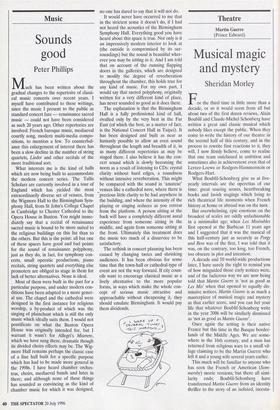Music
Sounds good
Peter Phillips
Much has been written about the gradual changes to the repertoire of classi- cal music concerts over recent years. I myself have contributed to these writings, since the music I present to the public as standard concert fare — renaissance sacred music — could not have been considered as such 20 years ago. Other repertories are involved: French baroque music, mediaeval courtly song, modern multi-media compo- sitions, to mention a few. To counterbal- ance this enlargement of interest there has been a slow decline in the number of string quartets, Lieder and other recitals of the more traditional sort.
What interests me is the kind of halls which are now being built to accommodate the modern concert series. The Tanis Scholars are currently involved in a tour of England which has yielded the most extraordinarily diverse set of venues, from the Wigmore Hall to the Birmingham Sym- phony Hall, from St John's College Chapel in Cambridge to Chester Cathedral to the Opera House in Buxton. You might imme- diately say that a recital of renaissance sacred music is bound to be more suited to the religious buildings on this list than to the others. But this is the point: all but one of these spaces have good and bad points for the sound of renaissance polyphony, just as they do, in fact, for symphony con- certs, small operatic productions, piano recitals, string quartets and everything. else promoters are obliged to stage in them for lack of better alternatives. None is ideal. Most of them were built in the past for a particular purpose, and under modern con- ditions have been adapted to a more gener- al use. The chapel and the cathedral were designed in the first instance for religious worship, a by-product of which was the singing of plainchant which is still the only music which ideally suits them. I would not pontificate on what the Buxton Opera House was originally intended for, but I warrant it wasn't for Allegri's Miserere, which we have sung there, dramatic though its divided choirs effects may be. The Wig- more Hall remains perhaps the classic case of a fine hall built for a specific purpose which has had to be made more general in the 1990s. I have heard chamber orches- tras, choirs, mediaeval bands and lutes in there; and although none of these things has sounded as convincing as the kind of chamber music for which it was designed, no one has dared to say that it will not do.
It would never have occurred to me that in the strictest sense it doesn't do, if I had not heard the acoustics of the Birmingham Symphony Hall. Everything good you have heard about this space is true. Not only is it an impressively modern interior to look at (the outside is compromised by its sur- roundings) but the sound is beautiful wher- ever you may be sitting in it. And I am told that on account of the cunning flapping doors in the galleries, which are designed to modify the degree of reverberation throughout the chamber, this holds true for any kind of music. For my own part, I would say that sacred polyphony, originally written for a very different kind of place, has never sounded so good as it does there.
The explanation is that the Birmingham Hall is a fully professional kind of hall, rivalled only by the very best in the Far East (of which the best, as a matter of fact, is the National Concert Hall in Taipei). It has been designed and built as near as humanly possible to allow an even sound throughout the length and breadth of it, in as many different repertories as may be staged there. I also believe it has the con- cert sound which is slowly becoming the norm as a result of listening to CDs: crystal clarity without hard edges, a roundness without intrusive reverberation. This might be compared with the sound in 'amateur' venues like a cathedral nave, where there is precious little clarity to be had anywhere in the building, and where the intensity of the playing or singing reduces as you retreat from the platform. A person sitting at the back will have a completely different aural experience from someone sitting in the middle, and again from someone sitting at the front. Ultimately this treatment does the music too much of a disservice to be satisfactory.
The rethink in concert planning has been caused by changing tastes and shrinking audiences. It has been obvious for some time that the town-hall or cathedral-type of event are not the way forward. If city coun- cils want to encourage classical music as a lively alternative to the more popular forms, in ways which make the whole con- cept of serious music attractive and approachable without cheapening it, they should emulate Birmingham. It would pay them dividends.


























































 Previous page
Previous page